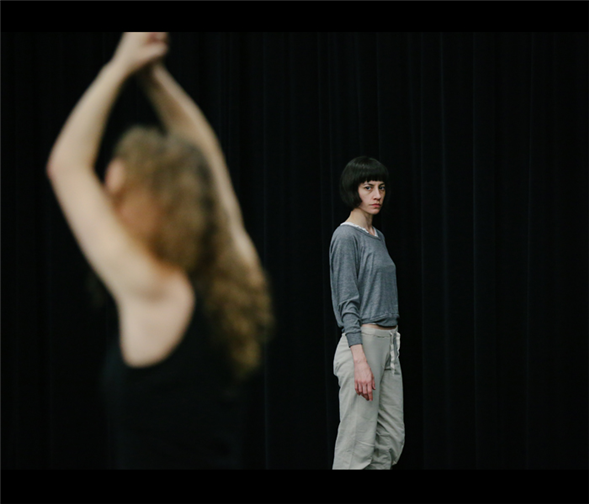Translate Page

Beth Gill's investigation of psychological space
---
Choreographer Beth Gill is an active listener, and for Catacomb, a new work that premieres at The Chocolate Factory on May 18, she's listening first to herself.
"At the beginning of this project there was a personal agenda to reconnect with a slightly older way of working for myself," she says. "What I remember most clearly from early adventures in dancemaking is that I was imagining and constructing the sense of the dance on my own. [I was] working either imaginatively or two-dimensionally in notebooks or paper."
With Catacomb, then, Gill has not jumped straight to creating movement on other bodies as many choreographers do. Discussing her more internal approach to the piece, she says, "What I realized [this way of working] afforded me was that the textures that I was coming up with – whether they were broad, spatial gestures or more conceptual gestures or clear physical material – all of it was coming from a slightly more subconscious space that I had created by working in a private way."
Gill's work – which finds remarkable nuance within formal dance technique – is often made for a theatre’s specific environment. Asked about the Chocolate Factory, she says, "I like its hardness. It’s not a clean, controlled space. I like that you are confronted by the lines of the architecture as a backdrop. The work has to be in relationship to it."
Meanwhile, just as she listens to herself and "listens" to spaces, Gill learns from long-term partnerships with her designers and dancers. In a modern art climate often characterized by quick projects and revolving-door collaborations, it is rare to see such enduring connections.
Sound designer Jon Moniaci, for instance, has worked with Gill since the early 2000s, winning a Bessie with her for Electric Midwife in 2011. For Catacomb, Moniaci's method mirrors Gill's privacy. Remotely, he makes "sketches" based on independent musical research and brings them back to the dance studio.
And whereas Moniaci often challenges our expectations for what instruments do – thus helping the audience listen in a new way – this time he's embracing their typical context. "In Electric Midwife I would use a piano, but it would be very textural," he says. "I wanted them to listen to the sound of the piano, but for this piece it's okay to see that there are associations with the piano that are more classical. That's a response to the emotion Beth is talking about."
Gill's process with her dancers relies on a similar give-and-take. Dancers Maggie Cloud, Jennifer Lafferty, Heather Lang, Marilyn Maywald, and Stuart Singer (most of whom have been with Gill for years) have taken personal responsibility for the direction of the work. "The culture of our workspace that gets set up in the studio is really mature," Gill says. "It has a lot of flexibility to it. We know how to multitask in terms of searching for ideas and then attending to our own needs at times. What I have experienced with them is that my role as a director is somehow able to soften. That's been a joy for me, to be in more of an active dialogue with them."
That dialogue may never end. Those who know Gill's work may see that each piece is a progression from the last, bringing disparate parts into a whole story of her exploration of "psychological space." She seems less interested in answering questions than in allowing more to arise, and when she's asked how she knows her work is finished, she says, "Hopefully there are always questions that are alive."
---
Follow Emeri Fetzer at @EmeriFetzer. Follow TDF at @TDFNYC.
Photo from Catacomb by Chris Cameron, courtesy of MANCC
Go here to browse our discounts for dance, theatre, and concerts.